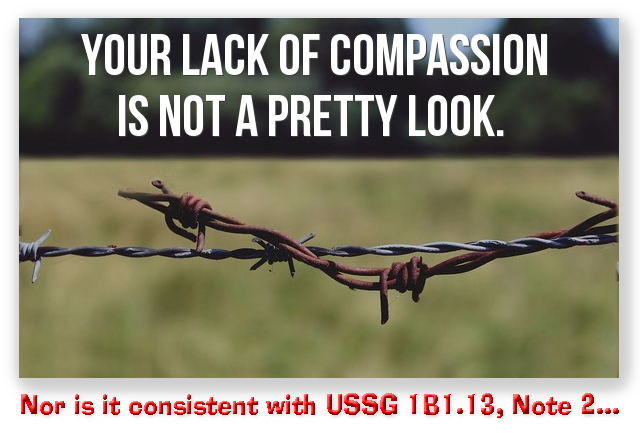We post news and comment on federal criminal justice issues, focused primarily on trial and post-conviction matters, legislative initiatives, and sentencing issues.

THE UNSTRUCTURED AND ARBITRARY WORLD OF COMPASSIONATE RELEASE, IN WHICH DISCRETION ONLY WORKS ONE WAY…
Someday, legal scholars may look back on COVID-era compassionate releases granted under 18 USC § 3582(c)(1)(A)(i) as having introduced more disparity and inconsistency in sentencing than any event in federal criminal law.
 A Sentencing Commission study last month tallied compassionate releases by district, released last month, reported that 22.3% of the 12,885 compassionate release motions filed in 2020 were granted. But if you filed one, your chances were not one out of 4.5, Instead, if your case came from the District of Oregon, your chances of a grant were 69.8%. If, however, your case came from the Western District of North Carolina, your chances were a lousy 1.5%.
A Sentencing Commission study last month tallied compassionate releases by district, released last month, reported that 22.3% of the 12,885 compassionate release motions filed in 2020 were granted. But if you filed one, your chances were not one out of 4.5, Instead, if your case came from the District of Oregon, your chances of a grant were 69.8%. If, however, your case came from the Western District of North Carolina, your chances were a lousy 1.5%.
There is no federal court district in the country with a poorer track record for compassionate release than Western District of North Carolina. During 2020, Western District judges heard 337 compassionate release motions. The judges denied all but five. By comparison, the Eastern District of North Carolina approved release in 25% of its 224 compassionate-release requests. The Middle District of North Carolina had an approval rate of 6.2%, granting 10 of 162 requests.
(The U.S. Virgin Islands had a 0% approval rate, but that court heard just six requests, the report says. By contrast, the Western District of North Carolina handled the sixth-highest number of compassionate release cases in the country last year.)
“The numbers are jarring,” one defense attorney said. “Your geography remains one of the most relevant factors in determining the sentence you receive or the severity of the punishment. In a country that guarantees equal protection under the law, I think that should raise some constitutional questions.”
That’s because appellate courts afford district judges a lot of discretion in deciding compassionate release motions, and – from time to time – confound things by issuing questionable decisions that tie up their district courts in procedural knots.
Case in Point #1: Take Jessica Ward, for example. She is around a third of a way through a 200-month drug sentence, and sought compassionate release in the Northern District of Texas due to chronic kidney failure. The government’s opposition argued that she did not meet Section 1B1.13 of the Sentencing Guidelines, in that the BOP was adequately managing COVID, but neither mentioned her kidney disease nor argued that 18 USC § 3553(a) sentencing factors should be relied on to deny her compassionate release motion.
The district court denied her motion because she did not meet USSG 1B1.13 and because § 3553(a) factors did not support a reduction. Jenny appealed.
 Last week, the 5th Circuit denied her appeal. It agreed that the district court was wrong to rely on USSG 1B1.13, because that Guideline does not apply when a prisoner files a compassionate release motion herself. But while the Government made no mention of the § 3553(a) factors, the Circuit “gives deference to the district court’s determination… We see no reason to hold that the Government’s failure to make arguments about the factors cancels the court’s statutory obligation to consider them.”
Last week, the 5th Circuit denied her appeal. It agreed that the district court was wrong to rely on USSG 1B1.13, because that Guideline does not apply when a prisoner files a compassionate release motion herself. But while the Government made no mention of the § 3553(a) factors, the Circuit “gives deference to the district court’s determination… We see no reason to hold that the Government’s failure to make arguments about the factors cancels the court’s statutory obligation to consider them.”
The 5th said the burden falls on the defendant to convince the court to grant compassionate release after considering the § 3553(a) factors. If the defendant fails to convince the district court to exercise its discretion, then the court may deny the motion, assuming it considers the § 3553(a) factors, for reasons the government may have never argued.
Lesson: Not only does a compassionate release movant have to address the arguments raised by the government, but he or she should address arguments that the court might raise on its own in the ultimate denial. The prudent defense attorney should thus have both a LEXIS/Westlaw account and a crystal ball.
Case in Point #2: Consider Ron Hunter, a one-time drug trafficking organization hitman convicted 21 years ago of murdering a 23-year-old woman outside a nightclub. As we like to say, Ron has kind of a tough fact pattern to argue… So tough that his sentencing judge sentenced him to life in prison.
Twenty-one years later, a different judge granted Ron’s motion for compassionate release. Based upon the fact that Ron did not get the benefit of the non-retroactive United States v. Booker ruling that Guidelines are not mandatory, on certain facts that existed at sentencing, and Ron’s rehabilitation efforts (which were far from perfect), the district court held the factors amounted to the “extraordinary and compelling reasons” required by 18 USC § 3582(c)(1)(A)(i).
 Should be no problem. right? After all, don’t circuits “give[] deference to the district court’s determination,” like the 5th Circuit said in Jessica Ward’s case? Makes sense, doesn’t it? But it turns out that it’s not necessarily so.
Should be no problem. right? After all, don’t circuits “give[] deference to the district court’s determination,” like the 5th Circuit said in Jessica Ward’s case? Makes sense, doesn’t it? But it turns out that it’s not necessarily so.
Last Monday, the Sixth Circuit reversed Ron’s compassionate release, holding that his new district judge abused his discretion.
The Sixth Circuit had already ruled last June in United States v. Jarvis that a “non-retroactive changes in the law [can]not serve as the ‘extraordinary and compelling reason’ required for a sentence reduction,” a holding at odds with most other circuits that have considered the issue. That meant that going in to oral argument, Ron was in trouble, because one of the grounds relied on his district court was that Booker would permit a sentence imposed today to vary from the Guidelines.
Now, the Sixth has built on the Jarvis blunder, ruling that “facts that existed when the defendant was sentenced cannot later be construed as “extraordinary and compelling” justifications for a sentence reduction.”
As Ohio State University law prof Doug Berman observed in his Sentencing Law and Policy blog, this holding “seems especially problematic and an especially misguided policy invention.” After all, the Sentencing Commission – which was given the duty by Congress to “describe what should be considered extraordinary and compelling reasons for sentence reduction” – held in Note 2 to Guideline 1B1.13, that
For purposes of this policy statement, an extraordinary and compelling reason extraordinary and compelling reasons need not have been unforeseen at the time of sentencing in order to warrant a reduction in the term of imprisonment. Therefore, the fact that an extraordinary and compelling reason reasonably could have been known or anticipated by the sentencing court does not preclude consideration for a reduction under this policy statement.
So while the Sentencing Commission has said facts known at sentencing can nevertheless be “extraordinary and compelling,” the Sixth Circuit says they cannot. It may well be that the Circuit was just put off at the idea of a hitman doing life going home after serving less time than a porn downloader. But there are ways to force the conclusion the judges wanted to see without pronouncing such a transparently wrong interpretation of the statute.
Lesson: Discretion is a rachet, in which the district court has free rein to deny but substantial restraint to grant, compassionate release.
Raleigh, North Carolina, News & Observer, Inmates seeking release from COVID-hit prisons have next to no chance in this NC district (August 27, 2021)
Ward v. United States, Case No 20-10836, 2021 U.S.App. LEXIS 25808 (5th Cir. Aug. 26, 2021)
United States v. Hunter, Case No. 21-1275, 2021 U.S. App. LEXIS 26115 (6th Cir. Aug. 30, 2021)
Sentencing Law and Policy, Sixth Circuit invents another extra-textual limit on what can permit a sentence reduction under 3582(c)(1)(A), including one in contradiction of USSC guidelines (August 30, 2021)
– Thomas L. Root

